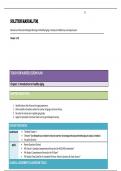Exam (elaborations)
Solution Manual for Ebersole and Hess Gerontological Nursing and Healthy Aging in Canada, 3rd Edition by veronique boscart Chapter 1-28
- Course
- Institution
Solution Manual for Ebersole and Hess Gerontological Nursing and Healthy Aging in Canada, 3rd Edition by veronique boscart Chapter 1-28
[Show more]



